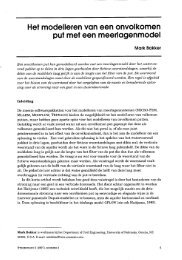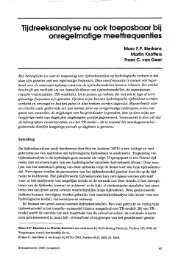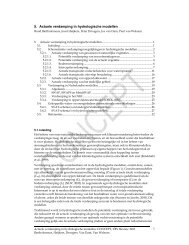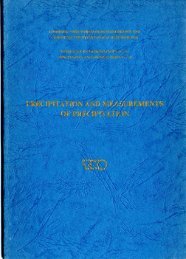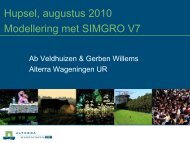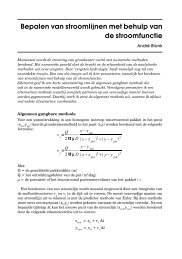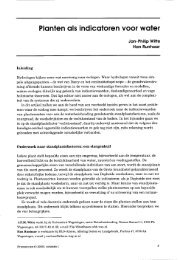Hydro-ecological relations in the Delta Waters
Hydro-ecological relations in the Delta Waters
Hydro-ecological relations in the Delta Waters
Create successful ePaper yourself
Turn your PDF publications into a flip-book with our unique Google optimized e-Paper software.
$oseibilities to create ptentially vaiuable breed<strong>in</strong>g sites for<br />
characteristic coastal breed<strong>in</strong>g birds. By meem of chang<strong>in</strong>g <strong>the</strong><br />
hydralogy, e.g. by (partially) <strong>in</strong>umlat<strong>in</strong>g 8maU polders adjacent to <strong>the</strong><br />
OostersmheLde ancl <strong>the</strong> Westerschelde, <strong>the</strong> importance far birds can be<br />
improved. In most places <strong>the</strong> ever <strong>in</strong>creas<strong>in</strong>g pressure bp recreational<br />
activities (boat<strong>in</strong>g, w<strong>in</strong>d-surfers, walk<strong>in</strong>g, bait-digg<strong>in</strong>g, fish<strong>in</strong>g etc.)<br />
is a serious threat to <strong>the</strong> various functions for birds. In particular<br />
<strong>the</strong> <strong>in</strong>tertidal areas are highly vulnerable to disturbance, and measures<br />
to reduca this disturbance are required. The same applies to some of<br />
<strong>the</strong> shallow parts of <strong>the</strong> Veerse Meer and Grevel<strong>in</strong>gen Meer, which are<br />
<strong>in</strong>creas<strong>in</strong>gly visited by w<strong>in</strong>d-surfers, not only <strong>in</strong> snmmer but also <strong>in</strong><br />
w<strong>in</strong>ter! Simple measures (snch as float* cablw) can be takeu to make<br />
at least dtome of <strong>the</strong>se areas <strong>in</strong>aceessibSe.<br />
6 CONCLUSION<br />
The Creation of new habitats by damn<strong>in</strong>g up eetuaries has, beyond doubt,<br />
<strong>in</strong>creased <strong>the</strong> diversity of bird life <strong>in</strong> <strong>the</strong> <strong>Delta</strong>. QT both breed<strong>in</strong>g and<br />
non-breed<strong>in</strong>g birds several species <strong>in</strong>creased <strong>in</strong> riders, Lass is known.<br />
havexer, on <strong>the</strong> changes <strong>in</strong> population size of <strong>the</strong> species Orig<strong>in</strong>aIly<br />
present, although <strong>the</strong>re are <strong>in</strong>dications <strong>the</strong>ir populations did not<br />
deurease markedly until 1984. Birds quiekly reacted to <strong>the</strong> MW<br />
habitats<br />
created, and <strong>the</strong> Voordelta, <strong>the</strong> estuaries, <strong>the</strong> al<strong>in</strong>e and <strong>the</strong> fresh<br />
lakes each have now <strong>the</strong>ir more or less tyaical avifauna. The gradient<br />
<strong>in</strong> abiotio and biotic ~onditions is very well lreflerted by <strong>the</strong><br />
distribution of <strong>the</strong> different bird groups a+ well as by <strong>the</strong> <strong>in</strong>dividual<br />
species, liowever, notwithscand<strong>in</strong>g <strong>the</strong> attention paid to nature<br />
consemation <strong>in</strong> <strong>the</strong> e l y czeared habitats. <strong>the</strong> estvarise areas still<br />
accomdate <strong>the</strong> largest numbers af birds. It ehould also be stressed<br />
that all estuar<strong>in</strong>e ec@wetems, and especially brackish and freshwarer<br />
tidal habitats are on a global scale very rare habitats, *hi& should<br />
MW be completely protected. Thelr loss can not be compensated bp <strong>the</strong><br />
creation of new habitats.<br />
For several bird species or groups it is s hm that <strong>the</strong>ir distribution<br />
and abundance is closely l<strong>in</strong>ked to that Oe <strong>the</strong>ir food sapply. An,y





